
© » KADIST
Judy Chicago
Domes #1 represents a significant moment in Chicago’s career when her art began to change from a New York-influenced Abstract Expressionist style to one that reflected the pop-inflected art being made in Los Angeles. By 1968, the year she began creating Domes , the twenty-nine-year-old artist had moved from Chicago to Los Angeles, graduated from UCLA, and was part of a generation of artists whose work was characterized by of the masculine overtones of Southern California’s flourishing car culture. Inspired by new technologies in the auto manufacturing, these “Finish Fetish” artists appropriated industrial materials such as car paint or lacquer to create artwork with pristine finishes.

© » KADIST
Julius Koller
The photograph Monologic – Yo-Yo 1, 2 (U. F. O. ), (1982), shows Koller playing with a big white Yo-Yo in a drab concrete building among a group of tower blocks.

© » KADIST
Julius Koller
Drawing & Print (Drawing & Print)
Anti-Happening refers to Koller’s 1965 manifesto, ‘Anti-Happening (System of Subjective Objectivity)’. In opposition to the notion of a ‘happening’ as a way of actualising group identity, in his manifesto, Koller stated that his concept of the ‘anti-happening’ aimed at a ‘cultural reshaping of the subject, at awareness, at the surroundings and the real world’ [i] . Unlike happenings, these actions do not involve the staging of psychologically expressive performances.

© » KADIST
Julius Koller
Drawing & Print (Drawing & Print)
Wordplay was a central focus of Koller’s work, in particular the acronym U. F. O., which he adapted in his diagrammatic drawings to stand variously for Univerzálna Futurologická Organizácia (Universal Futurological Organization, 1972–3), Univerzálny Filozoficky Ornament (Universal Philosophical Ornament, 1978) or Underground Fantastic Organization (1975), and which also appeared in a series of slapsticky self-portraits titled ‘U. F. O.–naut’ (1970–2007). These infinite variations on a common cipher constituted an insistent incantation of the Utopian principle.

© » KADIST
Julius Koller
Wordplay was a central focus of Koller’s work, in particular the acronym U. F. O, which he adapted in his diagrammatic drawings to stand variously for Univerzálna Futurologická Organizácia (Universal Futurological Organization, 1972–3), Univerzálny Filozoficky Ornament (Universal Philosophical Ornament, 1978) or Underground Fantastic Organization (1975), and which also appeared in a series of slapsticky self-portraits titled ‘U. F. O.–naut’ (1970–2007). These infinite variations on a common cipher constituted an insistent incantation of the Utopian principle.

© » KADIST
Larry Bell
Untitled (Construction) recalls the series of glass cubes that gained Bell international recognition in the 1960s. Resembling a black-mirrored box, this recent iridescent piece produces an uncanny effect in which the interior planes seem to enclose a mysterious light. Although austere in form, Bell’s works are far from simple: he uses technology like a vacuum-coating process, to accurately control the different levels of opacity and transparency on the surface of his immaculate glass works.

© » KADIST
Larry Bell
Drawing & Print (Drawing & Print)
Like many of Larry Bell’s works, VFGY9 deals primarily with the viewer’s experience of sight. The blocks resemble a stone carving, or slabs of wood shaped into a simple organic composition whose overall sheen is varied through a thin layer of aluminum vapor. Yet, the real material of Bell’s piece is actually light, formed within the viewer’s eye into masses as present as stone.

© » KADIST
Julius Koller
This work is one of Koller’s many variations which he began to use from 1970 to describe the ‘cultural situations’ he created. His “Anti-Happenings” turned mundane events into ‘cultural’ and ‘subjective’ situations. He sought to create new cultural situations that weren’t new art, but rather new ways of living: a new creativity for a new humanistic culture.
Julius Koller
- location: Pieštany, Slovenská Republika
- year born: 1939
- gender: male
- nationality: Slovakian
Larry Bell
- location: Venice, California
- year born: 1939
- gender: male
- nationality: American
- home town: Chicago, Illinois
Judy Chicago
- location: Belen, New Mexico
- year born: 1939
- gender: female
- nationality: American
- home town: Chicago, Illinois
-
1960-1969
Judy Chicago
1969Domes #1 represents a significant moment in Chicago’s career when her art began to change from a New York-influenced Abstract Expressionist style to one that reflected the pop-inflected art being made in Los Angeles...
-
1970-1979
Julius Koller
1978This work is one of Koller’s many variations which he began to use from 1970 to describe the ‘cultural situations’ he created...
Larry Bell
Drawing & Print
1979(Drawing & Print) Like many of Larry Bell’s works, VFGY9 deals primarily with the viewer’s experience of sight...
-
1980-1989
Julius Koller
Drawing & Print
1982(Drawing & Print) Wordplay was a central focus of Koller’s work, in particular the acronym U...
-
2000-2009
Larry Bell
2007Untitled (Construction) recalls the series of glass cubes that gained Bell international recognition in the 1960s...
